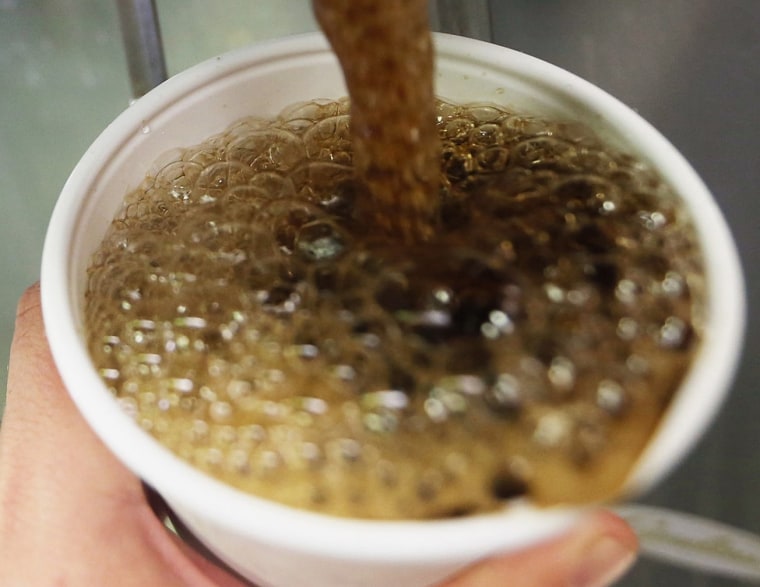Health advocates and the soda industry don’t agree on much, but both sides know a precedent when they see one―and both know that New York City tends to set them. The fast-food industry has largely abandoned artery-clogging trans fat since the city banned the stuff in 2006. The city’s menu-labeling initiative, requiring chain restaurants to put calorie information on public display, survived a string of industry lawsuits to inspire a federal rule. So when the city proposed an even more daring initiative last fall―a 16-ounce limit on the sugary drinks sold in restaurants, delis and food concessions―the industry pulled every lever to kill it. In October, a coalition that included the National Restaurant Association, the American Beverage Association, the International Brotherhood of Teamsters and various small business associations filed suit in New York State Supreme Court. This week, just hours before the portion cap was to take effect, the plaintiffs got their way.
In a Monday afternoon decision, the New York State Supreme Court ruled that the city’s board of health―the same appointed body that adopted the trans fat and calorie-posting policies―had overstepped its authority this time. “The City of New York’s Board of Health has very broad powers under the New York City Charter dating all the way back to its conception in 1698,” Judge Milton Tingling wrote in a 36-page decision. “However. . . the intention of the legislature [was] to protect the citizens of the city by providing regulations that prevent and protect against communicable, infectious, and pestilent diseases. . . One thing not seen in any of the Board of Health’s powers is the authority to limit or ban a legal item under the guise of ‘controlling chronic disease,’ as the Board attempts to do herein.”
Like the rest of the country, New York City faces different health threats today than it did 300 (or even 30) years ago. Diabetes and high blood pressure are as pervasive today as pestilence was in Colonial times, and the reasons are no secret. The average American’s daily energy intake surged by about 300 calories between 1970 and 2000, causing a three-fold increase in obesity. About half of that caloric boost came from sugary beverages, making them the biggest single contributor to the obesity pandemic. The judge may be right that an appointed board can’t legally address that threat by fiat, but the portion cap was one of the most promising health initiatives the industry has quashed to date.
It was never an easy sell. When the mayor unveiled the proposal last fall, The New York Times dismissed it as “too much nannying.” Jon Stewart lampooned the mayor for combining “the draconian government overreach people love, with the probable lack of results they expect.” The New Yorker served up a soda noir cover complete with police search lights trained on a couple in an alley with a large cup. And the beverage industry seeded a front group called New Yorkers for Beverage Choices to warn people that clueless bureaucrats were trying to repeal their most basic freedoms. Not surprisingly, polls found that 60% of ordinary New Yorkers disapproved of the measure.
Full disclosure: I once served as a clueless bureaucrat (New York City Health Department, 2006-2011), but this measure is getting a bum rap as a threat to personal freedom. The rule didn’t restrict individual behavior, let alone criminalize it. As the plaintiffs readily conceded, fans of the 64-ounce megacola could have gotten the same 54 teaspoons of sugar by knocking back four 16-ouncers. The regulation affected only what food service establishments defined as single servings. Six ounces was the norm during 1950s, and Coke promoted its first 16-ounce bottle as a perfect size for three (“Over ice―nice!”). But a standard portion has tripled since then, as manufacturing has become more efficient, and consumers have gone with the flow.
The truth is, we don’t make choices in a vacuum. As a well-established rule, we go with the defaults we’re offered. That’s why soda consumption has exploded since the 70s, and that’s why industry alone shouldn’t set nutritional norms. If a medication is harmful at standard doses, we lower the dose rather than warning the patient. Some people still overdose, but setting a reasonable default greatly lowers the risk. The Bloomberg soda initiative has a similar logic. If enacted, it would tweak our options and reduce our risks, while preserving our right to ill health. It isn't popular, and one court believes it's illegal. But Bloomberg says the city will appeal the decision, so don't assume the game is over. A mere 16-ounces may yet become the new normal.
